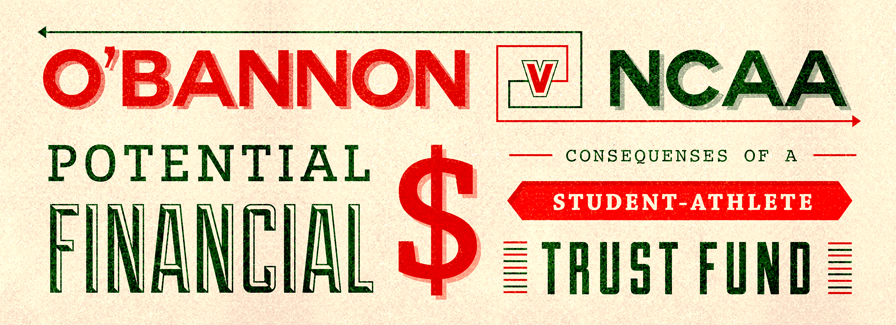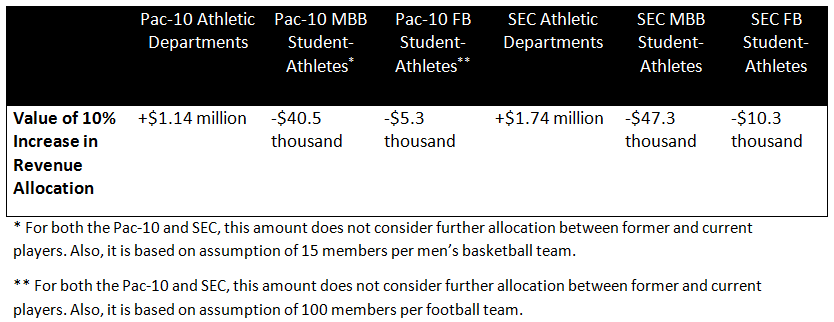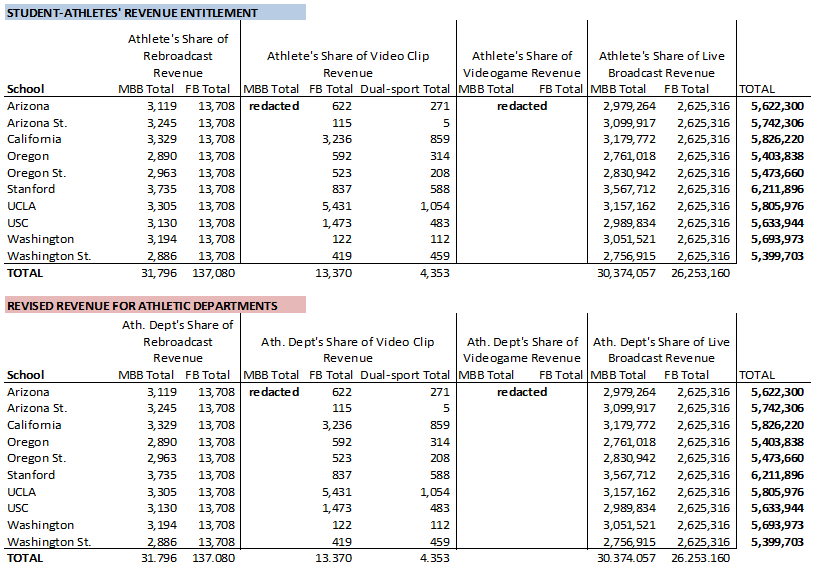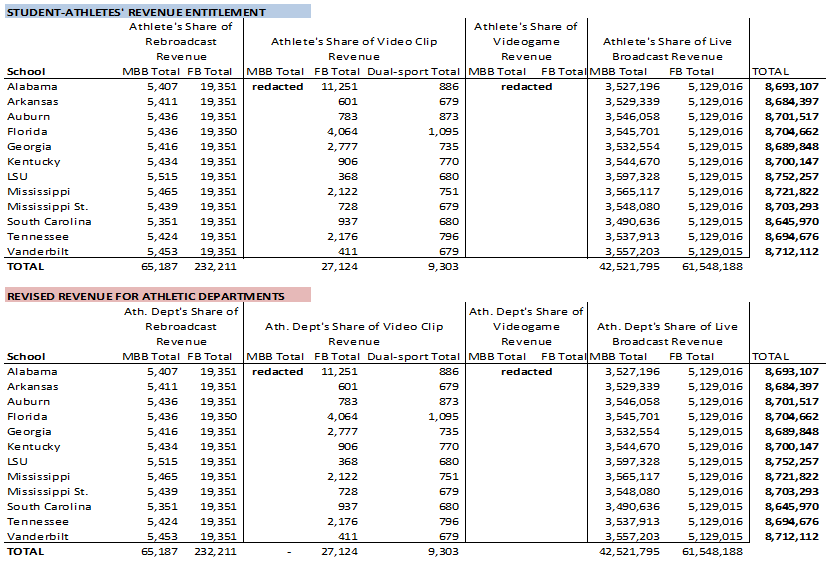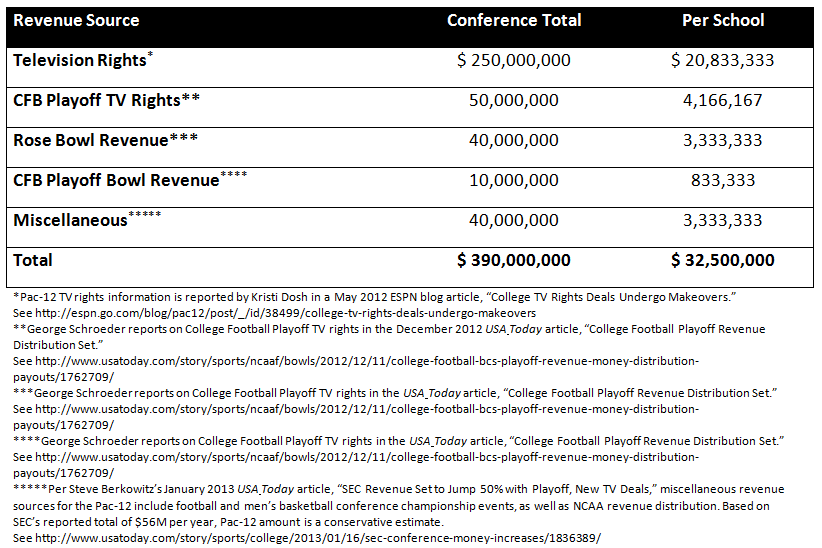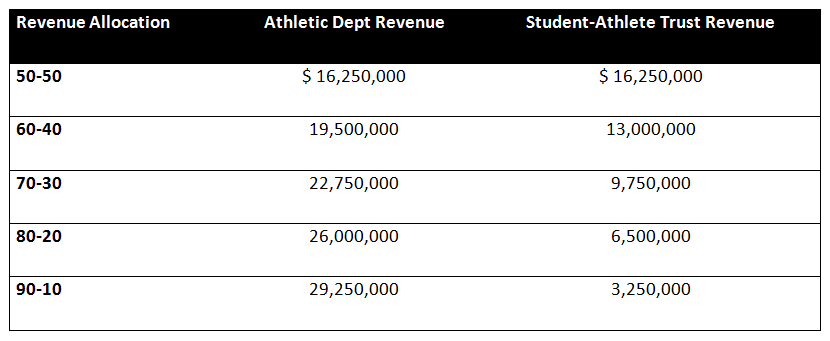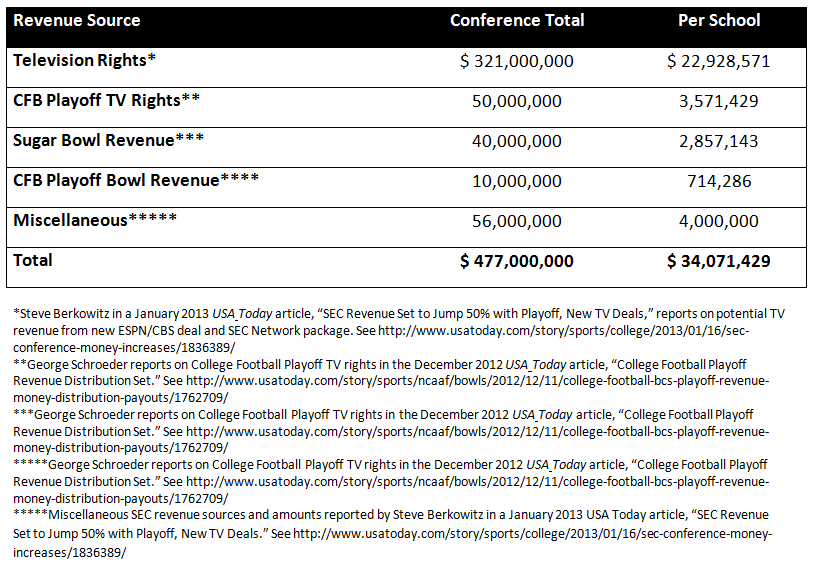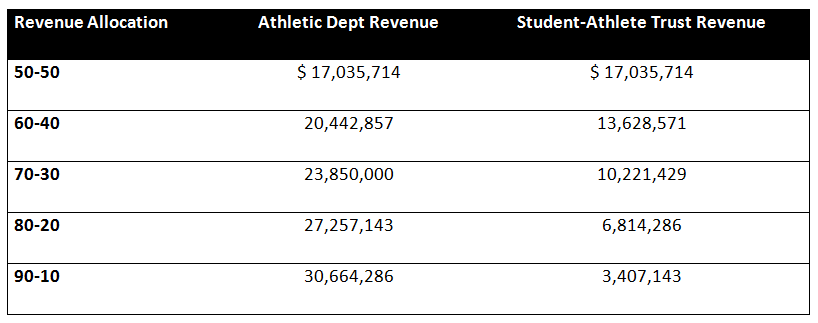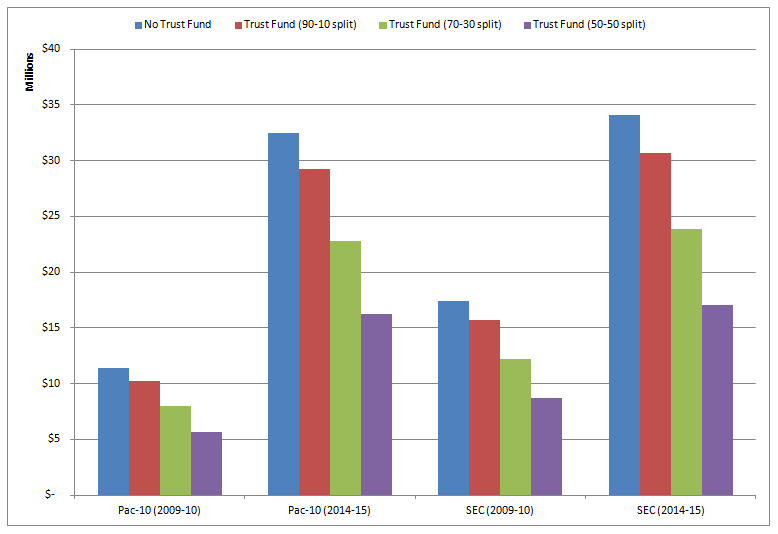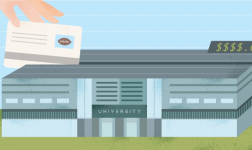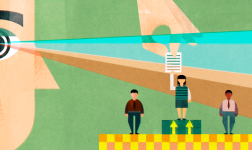By Peter Baran, Director of Compliance at Villanova University. Peter extends special thanks to Talor Bearman, the Managing Editor of the Vanderbilt Journal of Entertainment & Technology Law, and Christian Dennie, Esq., for their assistance and comments in writing this article.
In our previous article 1 examining Ed O’Bannon’s lawsuit against the NCAA, 2 we examined the legal and NCAA legislative issues that would arise out of a student-athlete licensing program. As the lawsuit has progressed, the plaintiffs have now advanced claims that lead us to explore a new potential outcome: a student-athlete trust fund. 3 Based on our analysis below, the creation of a trust fund could mean millions of dollars in lost annual revenue for athletic departments, while awarding men’s basketball and football student-athletes thousands of dollars each.
The central form of relief O’Bannon now seeks is the creation of a trust fund for current and former student-athletes. 4 The basic concept is fairly straightforward: money would be set aside from the revenue generated by television and licensing contracts and placed into a trust for student-athletes to access once their collegiate careers are concluded. It appears from media reports that the concept was discussed in 2007 through 2009 by officials from NCAA and CLC. 5 Also, in 2006, the “NCAA formed the Study Group on Names and Likenesses to examine the replacement of outdated legislation with contemporary rules that would provide greater flexibility to feature SAs in promotional material.” 6
Institutions and conferences are contemplating the broad implications of such a trust that would drastically alter the way that athletes are compensated (Oliver Luck heads “a committee within the Big 12 to explore what college sports might look like if the suit succeeds.”). 7 As Harvey Perlman, Chancellor at the University of Nebraska wrote in 2009, “This whole area of name and likeness and the NCAA is a disaster leading to catastrophe as far as I can tell.” A January 28, 2013 news story notes that: 8
If the Ed O’Bannon antitrust lawsuit over the use of college athletes’ name and likeness ever produces a payoff, there’s already a framework for players to collect NCAA revenue through a high-profile mediator. Prominent attorney Ken Feinberg is part of a registered organization called the Former College Athletes Association (FCAA). The entity registered March 22, 2011, with the corporations division of the District of Columbia’s Department of Consumer and Regulatory Affairs. Also on the FCAA’s board of directors is longtime sports marketing executive Sonny Vaccaro and National College Players Association president Ramogi Huma. A former O’Bannon attorney claims the FCAA is a potential “revenue stream” for the Washington D.C. law firm representing the plaintiffs, but Vaccaro and Huma say that’s not the case. “Our whole vision is to collect what should rightfully go to college athletes and make sure it gets to them,” Huma said. “We haven’t gone over too many details. I don’t think there’s anybody more respected than Ken Feinberg when overseeing trust funds.” Feinberg is best known for mediating claims by victims of the Sept. 11, 2011, terrorist attacks. He administered the Gulf of Mexico oil spill fund and is currently helping Penn State negotiate settlements with victims from the Jerry Sandusky sex-abuse scandal. Vaccaro said forming the FCAA is simply a first step should the plaintiffs win against the NCAA, EA Sports and Collegiate Licensing Company, and added that no one is being paid from the entity.
The focus of this article is to explain the legal case as it currently stands. Thus, the article is divided into two parts.
In Section I of this article, we consider what is the new legal framework of the case and how does that potentially lead to the creation of a trust fund?
In Section II of this article, we consider what a trust fund for current and former student-athletes might look like with real world financial implications. Using financial data from several collegiate institutions, conferences, the NCAA, and the Win AD databases, we create a model of the trust fund, considering what levels of financial support such a fund could feasibly provide to former and current student-athletes.
Section I – Legal
When initially filed in May of 2009, the O’Bannon lawsuit alleged an anti-trust violation against the National Collegiate Athletic Association (NCAA) and the Collegiate Licensing Company (CLC). The plaintiffs argued that the NCAA violated antitrust law by failing to compensate former student-athletes for using their likeness in a variety of forms (notably video games, television broadcasts, and memorabilia). During discovery, the plaintiffs sought documents, numbering in the hundreds of thousands, from the NCAA. In addition, plaintiffs filed discovery motions against third parties, such as ESPN, to acquire media rights contracts thereby in an attempt to better ascertain the value of the various rights from which the plaintiffs claimed they were not allowed to profit. Over the objection of the NCAA and ESPN, the court ordered ESPN to turn over its television and licensing contacts for Division I men’s basketball and football since 2005. 9
After these media contracts were turned over, and perhaps driven by the potential exploitative nature of the financial data contained therein, 10 plaintiffs’ lawyers began to take a new tack. As stated, the plaintiffs’ initial claim was on behalf of former student-athletes. On August 31, however, plaintiffs filed a motion to expand the lawsuit to include current Division I football and men’s basketball players. This is a significant expansion (particularly according to the NCAA) from the initial claim filed back in 2009.
Plaintiffs do not want the current student-athletes to be compensated while in college, but rather are asking that a trust fund to be set up which student-athletes can access once their collegiate playing days are concluded. The plaintiffs suggested the trust fund be maintained financially from one-half of the NCAA’s broadcasting revenue and one-third of the revenue from the licensing of video games. In the second half of this article, we will look at the financial ramifications of such a trust fund, modeling several possible outcomes, including scenarios that would account for less generous results, should the athletes prevail.
The motion to expand the lawsuit has been met with skepticism and even downright ire by the NCAA. The NCAA also filed a motion to strike the plaintiff’s motion to include current student-athletes based on myriad of legal reasons. The NCAA’s central argument against the motion is that the plaintiffs started seeking relief for former student-athletes, a claim that, according to the NCAA, was dead in the water. When the claim for former student-athletes was no longer viable, the plaintiffs pressed to turn the case into a class action lawsuit involving all student-athletes, current and former. The NCAA stated that this renders meaningless the years of litigation already spent defending the initial lawsuit and wastes countless time and money spent on discovery, all for a new theory of the case, which (from the NCAA’s point of view) is even less likely to succeed than the first. The NCAA filed several motions and has devoted a section of its website to the litigation which illuminates these positions more clearly. 11
The NCAA’s argument that the plaintiffs’ initial claim for former student-athletes was not viable is based, in part, on several statements given during deposition by two of the plaintiffs, Tyrone Protho 12 and David Lattin 13 (both former student-athletes). When asked by NCAA counsel, Protho responded that he understood that he was free to sell his likeness rights and that the NCAA did not have exclusive rights to his likeness. Lattin responded in kind, stating that he was able to receive compensation for selling the story of his time as a student-athlete to ESPN. Given these answers, the NCAA has questioned the validity of the plaintiff’s claim, which is based on the lack of former student-athletes’ right to sell their likeness (via the NCAA Student-Athlete Statement). 14
The plaintiffs’ motion to include current student-athletes is, the NCAA has contended, a complete departure from the plaintiffs’ original legal theory of the case. Specifically, the NCAA argued in its motion to strike that the plaintiffs shifted their legal theory of the case by including current student-athletes. Initially, the plaintiffs argued that they were required to indefinitely turn over their likeness rights to the NCAA via forms (NCAA Student-Athlete Statement), 15 such that they could profit off of the sale forever. Now, states the NCAA, the plaintiffs are alleging that the NCAA’s amateurism and eligibility rules (which prevent current student-athletes from being paid to play) violate the antitrust laws. As the NCAA is quick to point out, antitrust claims based on the NCAA’s principles of amateurism have been defeated in the courts. 16
The NCAA claims that the plaintiffs’ change from a form-based theory to a rules theory of the case misled, confused, and manipulated the courts. 17 The NCAA has argued that once the plaintiffs realized that their forms based theory of the case would not be successful, they attempted to change their legal theory of the case. Donald Remy, NCAA Executive Vice President and General Counsel explained, “[The plaintiffs’] old theory was wrong on the facts, and their new theory is wrong on the law. The U.S. Supreme Court and numerous lower courts have determined that the NCAA’s amateurism rules are fully consistent with the nation’s antitrust laws.” 18
The tens of thousands of documents (Noll Report – NCAA Expert Report of Roger Noll) turned over and examined by both parties would be, the NCAA is arguing, in large part, rendered wasted if the court permits the plaintiffs to alter their theory of the case. 19 Moreover, the court’s decision to require the NCAA and third parties (such as ESPN) to turn over thousands of documents was based, in part, on the representations that the plaintiffs made based on the initial theory of the case.
The plaintiffs, however, are not without their own legal arguments. In support of their motion, the plaintiffs hired Roger Noll, 20 a well-known economist and Stanford Professor, to file an extensive 109-page report (Noll Report – NCAA Expert Report of Roger Noll), and separate 111-page document of Exhibits to the Report (Noll Report – NCAA The Antitrust Economics of NCAA Restrictions on Athletic Scholarships), with the court. Therein, Noll alleges that the NCAA committed antitrust violations through a combination of price fixing and rules enforcement. “The NCAA is a mechanism through which its members engage in effective price collusion that is backed by the penalty of severe punishment, even exclusion from intercollegiate athletics, of any college or student-athlete who breaks the rules that implement price collusion.”
Noll further argues that although student-athletes are willing to sign over their likeness rights to the NCAA, the willingness to do so is not proof that the NCAA is not engaging in price collusion. In fact, Noll argues just the opposite. “[A]ll customers who pay a monopoly price are in the same position. Collusive monopoly is profitable only if a sufficient large number of people value a product by more than the monopoly price. The fact that such people exist does not provide a justification for engaging in collusion because the ability to collude is not the result of superior efficiency and foresight. [via Noll Report – NCAA Expert Report of Roger Noll]”
The plaintiffs’ have made a motion to include current student-athletes and the certification hearing 21 set for June, 20th 2013. 22
Section II – Financial
Let’s assume plaintiffs’ prevail and the court rules that a trust fund is the proper remedy. What would the distributions look like? We ask that question to explore for practitioners the possible new fiscal operating environment. A helpful starting point is plaintiffs’ position on such damages, which is articulated in the expert testimony of Dr. Roger Noll on the plaintiffs’ behalf.
By way of background to Dr. Noll’s Report, listed below are the most salient assumptions, methodologies, and parameters underlying the hypothetical trust funds.
- The trust funds shown incorporate revenue from three sources: telecasts of live and archival games, sales of highlights and game clips, and video games. In his report filed with the court, Dr. Noll notes these aren’t the only potential revenue sources for a trust fund, but instead the only areas where there is currently enough sufficient information to “support a reasonable damage calculation. [pg. 96 of Noll Report – NCAA Expert Report of Roger Noll]” Additionally, Dr. Noll notes in his report that he has estimated certain school data where necessary based on the averages of school information for which sufficient information was provided. [pg. 97 of Noll Report – NCAA Expert Report of Roger Noll]
- According to Dr. Noll’s report filed with the court, the appropriate allocation of broadcast and video clip revenue between student-athletes and athletic departments is 50-50, while video game revenue is split 2 to 1 in favor of athletic departments [pg. 102 of Noll Report – NCAA Expert Report of Roger Noll]. (As this formulation is a plaintiffs’ claim, we provide a sensitivity analysis for greater than 50% of the distributions to the athletic departments.)
- Roger Noll’s report projects figures for broadcast revenue, but the numbers for the videogame revenue have been redacted. Therefore, a little creativity is needed to attempt to project those figures. In 2007, a group of retired NFL players filed a class action lawsuit against the NFL Players Association (NFLPA). The players alleged that the NFLPA’s licensing agreements with companies like EA required exclusive dealing with the NFLPA, which unfairly interfered with their licensing opportunities. The jury in the case awarded the players a judgment of $28.1 million for breach of fiduciary duty. The award consisted of $7.1 million in compensatory damages and $21 million in punitive damages. Using the $7.1 million figure, it is possible to roughly estimate the figures that Noll may have suggested.
- The class of retired NFL players consisted of 3,631 former professional football players. Thus, the jury found that each player was entitled to $1,995.38. Using the same year as Noll, who focused on 2009-2010 in his report, Madden 2010 sold 7.39 million units, whereas, EA Sports NCAA Football 2010 sold 2.49 million units in the same year. This relationship yields a ratio of 33.69%. These figures represent a very rough projection. Noll proposes a 1/3 split for players, but it is unclear from the opinion how the jury in the NFLPA case calculated their compensatory award (i.e., whether that represented a split between the players and the NFLPA or if that was 100% of the videogame earnings. 23
- All revenue streams are allocated between football and men’s basketball wherever possible. Football and Men’s Basketball student-athletes represent the “injunctive class,” and therefore are the two athletic programs to be analyzed [Pg. 6 of Noll Report – NCAA Expert Report of Roger Noll].
- Revenue allocated for football and men’s basketball student-athletes will be placed into a trust which would pay entitled amounts upon either graduation or exhaustion of eligibility. Revenue allocated for an athletic department would be treated as ordinary revenue and be a part of a department’s operating budget for the year in which revenue is received.
- The sub-allocation of revenue among current and former student-athletes (not displayed) is straightforward. All revenue will need to be allocated and earmarked not only to football and men’s basketball, respectively, but also to specific years. Attributed revenue for both current and former student-athletes’ is then split evenly among those on respective rosters for a given year. As live broadcasts drive the overwhelming majority of rights fees, the bulk of revenue entering into the trust fund will be for current student-athletes and can be cleanly allocated between football and men’s basketball based on a school/conference’s contract. Further, current year’s revenue can be easily allocated to each entitled student-athlete based on that year’s roster [pg. 107 of Noll Report – NCAA Expert Report of Roger Noll].
With the foregoing in mind, in Section II we cover three areas:
First, in Part 1 below, we will display the potential trust funds as modeled by plaintiffs’ expert Dr. Noll in the publically available report that was filed with the court. He modeled the Pac-10 (see Table 3, below) and Southeastern (see Table 5, below) conferences based on available financial data from 2009-10. 24 In addition to the models developed by Dr. Noll, we show the range of fiscal impacts depending upon the revenue allocation percentages (Tables 4 and 6, below), if a trust fund were to come into existence. Using the plaintiffs’ request of a 50-50 split as one end of a range of fiscal impacts, we measure each 10 percent incremental shift through a 90-10 split in favor of athletic departments. For athletic departments and student-athletes alike, the financial ramifications going from one end of the spectrum to next are very significant (Table 1, below)—Pac-10 schools recoup an additional $1.14 million for each 10 percent incremental increase in revenue allocation, while Pac-10 men’s basketball student-athletes yield about $41 thousand and football student-athlete’s yield about $5 thousand. Similar is the SEC, where each 10 percent incremental increase in revenue allocation would allow athletic departments to recoup about $1.74 million, while men’s basketball student-athletes yield about $47 thousand and football student-athletes yield about $10 thousand.
Table 1: Effects of Incremental Increase in Revenue Allocation, Estimated 2009-10 Financial Data
Second, in Part 2 below, we present estimated annual revenue distribution amounts to schools in the Pac-12 and SEC based on reported financial amounts for 2014-15 (Tables 7 and 9, below). In each conference’s estimated annual revenue we include reported figures for TV rights deals, the new college football playoff TV rights, new bowl-specific revenue, and other miscellaneous sources. Additionally, we show the range of fiscal impacts on athletic department revenue amounts and student-athlete trust fund amounts (Tables 8 and 10, below) depending on revenue allocation percentages. Specifically (Table 2, below), Pac-12 athletic departments recoup $3.25 million of revenue with each 10 percent incremental increase in revenue allocation (with the Pac-12 student-athlete trust yielding the same amount), while SEC athletic departments recoup $3.41 million that would otherwise go into their student-athlete trust.
Table 2: Effects of Incremental Increase in Revenue Allocation, Estimated 2014-15 Financial Data
Please note we cannot calculate revenue on a per student-athlete basis for football and men’s basketball because we are not privy to the allocation of rights fees between the two sports (unlike Dr. Noll in his 2009-10 trust fund examples). However, from a broad perspective, we know per student-athlete revenue amounts can only increase due to increasing overall rights revenue.
Third, in Part 3, we highlight and discuss the biggest effects we foresee for athletic departments should the court rule in favor of the plaintiffs and this type of trust fund environment come to fruition.
Part 1: Trust Fund Models of the Pac-10 and SEC (2009-10)
Table 3: Damages Summary by Category, Pac-10, 2009-10 (the 50-50 case)
[Exhibits to Noll Report – NCAA Expert Report of Roger Noll, Exhibit 12A, p.55]
Table 4: Sensitivity Analysis of Pac-10 Revenue Allocation, 2009-10
Table 5: Damages Summary by Category, SEC, 2009-10 (the 50-50 case)
[Exhibits to Noll Report – NCAA Expert Report of Roger Noll, Exhibit Exhibit 13A p.57]
Table 6: Sensitivity Analysis of SEC Revenue Allocation, 2009-10
Tables 3 and 5 are example trust funds built by Dr. Noll as part of his expert report on behalf of the plaintiffs. The models contain data for the Pac-10 and SEC, respectively, for the 2009-10 academic year. 25
Part 2: Estimated Revenue Distribution Amounts for the Pac-12 and SEC (2014-15)
Table 7: Estimated Pac-12 Revenue for 2014-15
Table 8: Sensitivity Analysis of Pac-12 Revenue Allocation, 2014-15
Table 9: Estimated SEC Revenue for 2014-15
Table 10: Sensitivity Analysis of SEC Revenue Allocation, 2014-15
In the year 2014-15, each school in the Pac-12 is estimated to receive over $32 million from television rights (both conference and playoff), Bowl Revenue and other miscellaneous sources. This amount is at least a 180% increase per school from the 2009-10 data. Similarly, the SEC will likely distribute over $34 million to each of its member schools in 2014-15, an increase of over 100% from 2009-10.
Under the trust fund scenario put forth by Dr. Noll and the plaintiffs, athletic departments for each school would be entitled to exactly half this revenue (about $16 million for Pac-12 schools, and $17 million for SEC schools), with the other half put into a student-athlete trust to be allocated between current and former student-athletes in football and men’s basketball. The 50-50 revenue split again, though, is the allocation put forth by the plaintiffs, and as this represents their most favorable outcome, our sensitivity analysis provides information all along the potential revenue allocation spectrum.
Part 3: Effects of Trust Funds on Athletic Departments
There would be countless effects to athletic departments should a compensation plan like the trust fund scenario described above come to fruition. 26 Universally, schools would lose a significant chunk of operating revenue. Just what percentage of a school’s budget would go to a student-athlete trust fund isn’t exactly clear, but here’s one way to potentially think about it.
The total revenue amounts received by each school from broadcast rights in 2009-10 for the Pac-10 and SEC ($11 to $12 million and $16 to $17 million, respectively) would be roughly in line with the revenue each school, in each conference, is estimated to receive in 2014-15 post a trust fund implementation ($15 million for Pac-12 schools, $17 million for SEC schools) under the likely worst case scenario. In other words, holding all other revenue sources equal, schools would be operating in 2014-15 with budgets that looked, perhaps at best, very similar to 2009-10. Table 11 below shows this worst-case scenario visually, as well as mid-case scenarios (70-30 split) and best-case scenarios (90-10 split). For Pac-12 schools at least, relinquishing revenue to a student-athlete trust fund could pose a challenge as many institutions have already begun investing the new funds in major facilities improvements. 27
Table 11: Average Athletic Department Revenue, at Varying Revenue Allocations
We conclude by recognizing that there are countless questions, more raised than answered, under a hypothetical trust-fund environment as laid out above. Our focus, again, is not to prognosticate on what will necessarily happen, but instead sketch out a hypothetical operating environment for practitioners to consider at this point given the publicly available information of the case. It is impossible to intuit the ruling and exact implications, but, as The Sporting Digest recently noted: 28
Judge Wilken has in the past few months issued other rulings relating to discovery in the case that have favored the plaintiffs and allowed them to attempt to gather evidence that the NCAA was trying to block on procedural grounds. As the case is now unfolding, there seems to be an increasing likelihood that the court will eventually deny any defense motion for a summary judgment. This would, in effect, ensure that the case would go to trial before a jury, which is currently scheduled to take place in June 2014.
Presented below is a small sample of the high-level questions and issues that occur to us and which would need to be resolved if student-athlete trust funds are to become reality.
- What are the Title IX implications of a trust-fund scenario?
- Should administration and distribution of a trust fund occur at a national level, or is it something the compliance department at each school would handle?
- What are the tax implications to both student-athletes and schools?
- Does a trust-fund fit with current employment and labor laws?
- Could a trust fund pave the way for student-athletes to unionize in a way similar to the various players’ associations and unions in the professional leagues?
- How do schools meet the financial demands of a trust fund, both in relation to non-revenue generating sports and their overall university/athletics missions?
- If TV rights are the key driver of a trust fund, will it make sense for schools and conferences to negotiate for top dollar in future rights deals?
- As TV rights differ from conference to conference, will the amount each student-athlete is entitled to in a trust become the key recruiting factor in football and men’s basketball?
- And if recruiting is driven by trust payouts to student-athletes, will schools realign around the group which can yield the highest rights fees possible? Will this group become its own division, separate from the vast majority of other schools?
Key Insights
We examined the legal case of Ed O'Bannon versus the NCAA and the potential financial consequences of a student-athlete trust fund. We look at where the case stands now from a legal standpoint as well as modeling what a trust fund would look like using several possible outcome based on publicly available documents. The outcome of the case, should the plaintiffs prevails, could have longstanding consequences for college athletics.
References:
- http://winthropintelligence.com/2012/05/06/student-athlete-licensing-program-how-could-it-happen-and-what-are-the-elements/ ↩
- See ~ 1.5 minutes of discussion at the 8:30 minute mark at Part 3, here http://chronicle.com/article/What-Lies-Ahead-for-College/130280/
See generally http://www.pbs.org/wgbh/pages/frontline/money-and-march-madness/ncaa-lawsuit/#1 ↩
- For another basic outline see
http://www.theatlantic.com/business/archive/2013/01/the-ncaa-vs-student-athletes-the-end-of-the-the-best-business-model-in-the-world/272695/ ↩
- This case is styled Ed O’Bannon v. NCAA, 2010 U.S. Dist. LEXIS 19170 (N.D. Calif. July 9, 2009) (No. CV 09-3329). A full copy of the complaint can be found online by using the citation for an internet search. ↩
- In 2007, through “a separate series of e-mails between NCAA officials … then-NCAA Vice President Greg Shaheen made a push for the NCAA to adopt legislation that would allow EA to use the names and likenesses of current athletes. Shaheen argued that if the NCAA polled athletes, they would overwhelmingly want their names used. ‘The issue for me is that the names and likenesses are rigged into the games now by illegal means, meaning that many of the video game players have the features, it’s just that our membership doesn’t benefit from it,’ Shaheen wrote. Shaheen wrote that sales numbers showed the NCAA basketball video game was unsustainable without providing the realism expected from video games. If the likeness issue was solved, Shaheen said, he estimated using athletes’ names would be worth more than the $4 to $8 million annually that’s made from the current model.” http://www.al.com/sports/index.ssf/2012/11/ncaa_knew_ea_sports_video_game.html
He discussed the possibility of creating the “College Vault Players Association” [a potential mechanisms to license revenue for former athletes] according to e-mails filed in the O’Bannon case.” See http://www.al.com/sports/index.ssf/2013/01/ed_obannon_plaintiffs_have_org.html
Also, “In one email exchange from July 2007, an executive with the Collegiate Licensing Company (CLC), which represents the NCAA and its member schools, noted that EA Sports was using real player names to develop the latest game internally, with plans to strip them out before release to the public. ‘Just a heads up, in case schools ask you this — all of EA’s latest 2008 March Madness basketball submissions have current players names on the jerseys in the game,’ wrote Wendy Harmon, a CLC marketing coordinator. ‘I have called Gina Ferranti at EA about this (she submits all of these basketball ones) and she assured me that they will not be using those in the final version. She said they have to put the players names in so it will calculate the correct stats but then they take them off. Just don’t want the schools to freak out — she said a few have already commented on it in their approval.’ An hour later, CLC senior vice president and managing director Derek Eiler forwarded the email, notifying other top executives. He wrote, ‘Just an FYI on this in case word reaches the NCAA. This is exactly the type of thing that could submarine the game if it got into the media.’ See http://espn.go.com/espn/otl/story/_/id/8396753/ncaa-policy-chief-proposes-dropping-student-athlete-term
“At a [CLC] company retreat in September 2009, senior leadership introduced the idea of organizing former players into an entity called the ‘College Vault Players Association,’ whose purpose, according to an email by one CLC executive, would be to ‘do whatever is necessary to assure that the licensing and marketing rights of former collegiate student athletes are protected and revenue opportunities are pursued.’ The CLC’s proposed 16 founding members of the CVPA would include Michael Jordan, Brian Bosworth, Dick Butkus, Joe Montana, John Elway, Deion Sanders and the Manning brothers. It is unclear from the document whether those players had been contacted or were on board with the plan to negotiate with their schools. The CVPA would pursue deals with companies in a range of sectors, including trading cards, games, videos, jerseys, books, photographs and collectibles. One of CLC’s top executives was intrigued enough with the idea that he wondered if the group should expand beyond former players. On December 30, 2009, senior vice president Cory Z. Moss asked, ‘Should we really begin work on a formal College Student Athlete Players Association (current and former) to be ready depending on the results of the EA lawsuits?’
More on likeness:
http://kaburakis.com/index.php/news-2/research-updates/77-trilogy-wrap ↩
- See http://papers.ssrn.com/sol3/papers.cfm?abstract_id=1434986 NCAA Student-Athletes’ Rights of Publicity, EA Sports, and the Video-Game Industry. The Keller Forecast. Entertainment and Sports Lawyer, Vol. 27, No. 2, 2009 (footnotes for the following quote are omitted): “In 2006, the NCAA formed the Study Group on Names and Likenesses to examine the replacement of outdated legislation with contemporary rules that would provide greater flexibility to feature SAs in promotional material. The Study Group picked up where Proposal 2005-26 left off. If Proposal 2005-26 was not withdrawn, it would have permitted institutional, charitable, educational, and nonprofit organizations to display a logo or product description on promotions, provided it did not exceed 25 percent of the total promotion and athletes did not directly encourage the use of the product. The Study Group, using Proposal 2005-26 as a starting point, created three proposals in 2007 for governing promotional usage of SAs by: (1) institutional, charitable, educational, and nonprofit entities (Proposal 2007-25); (2) commercial entities (Proposal 2007-26); and (3) media entities (Proposal 2007-28) (see Table 1). For example, Proposal 2007-26 would have allowed video, audio, and photographs of SAs with eligibility remaining (substantial deviation from past norm) to be featured in promotional material, provided the SA did not directly endorse the product. The Study Group’s rationale was that showing video or pictures of athletes in competition did not create a direct endorsement of a product, as is common in professional sports. The Study Group also noted that “the increased flexibility may increase the ability of an institution to strengthen its relationship with commercial sponsors.” The three proposals were initially tabled for discussion on how to balance the proposals with the role of commercialism in higher education. Discussion of the 2007 proposals ranged from formal NCAA Convention meetings, to popular press, to SA input. When proposals that impact SAs are considered by the NCAA, decision makers often look to the NCAA Student-Athlete Advisory Committee (“SAAC”) to ascertain SAs’ stances on the issue. In 2007, NCAA Division I SAAC Vice Chair Kerry Kenny indicated that the current rules needed updating and that he and the Division I SAAC were “for any legislation or direction the NCAA was going to take.” In addition to the comments by Kenny, minutes from 2008 and 2009 NCAA Division I SAAC meetings indicate the group discussed commercialization. Other SAAC groups discussed a need for more specific information. In 2008, the Southeastern Conference (“SEC”) SAAC noted concerns that legislation might result in opportunities only for football and basketball SAs and might be considered “career development.” Beyond this concern, the group was in support of SAs serving as spokespeople for their schools. Sports industry finance consultant, Marc Isenberg, saw an inherent problem in expanding the ability of companies to use athletes’ images. Specifically, Isenberg felt that SAs will “retain little if any control over the athletic department’s use of their likenesses…In addition to the 2006 Study Group on Names and Likenesses and the 2009 Task Force on Commercial Activity, NCAA President Dr. Myles Brand addressed the issue of SA likenesses in his blog post and 2009 State of the Association Address. In his September 9, 2008, blog post, Brand disagreed with the C.B.C. v. MLBAM45 decision, which impacted the use of SA names in college football fantasy leagues. Brand noted the NCAA cannot sue CBS, which produces the fantasy game, because the right of publicity is held by the SAs and not the NCAA. Thus, the NCAA “would find it difficult to bring suit over the abuse of a right [it doesn’t] own.” Brand also noted in his 2009 State of the Association Address that the confluence of the Internet and reality animation has made it difficult for content providers, such as the NCAA, to control the use of athlete names and likenesses. The Task Force made the same observation regarding computer simulation (e.g., video games). According to the Task Force, “The concept of convergence, which will merge the interactivity of…computer simulation with television broadcast, will need to be interpreted as it relates to the appropriate uses of student-athlete names and likenesses.” ↩
- See http://www.al.com/sports/index.ssf/2012/10/big_12_to_study_what_ncaa_migh.html ↩
- See http://www.al.com/sports/index.ssf/2013/01/ed_obannon_plaintiffs_have_org.html ↩
- See http://sportsillustrated.cnn.com/2012/writers/michael_mccann/10/02/Ed-O-Bannon-ESPN/index.html ↩
- See http://sportsillustrated.cnn.com/2012/writers/michael_mccann/10/02/Ed-O-Bannon-ESPN/index.html
“And yet divulging information they consider privileged is not the greatest worry for these companies. Instead, it’s this: relinquishing private knowledge about how much they have profited from the labor of college athletes illuminates these companies’ own susceptibility to being sued by O’Bannon.” ↩
- See http://www.ncaa.org/wps/wcm/connect/public/NCAA/Resources/Latest+News/2012/September/Student+athlete+likeness+lawsuit+timeline ↩
- Tyrone Protho is a former student athlete at the University of Alabama. ↩
- David Lattin is a former student athlete at Texas Western. ↩
- The NCAA has specifically questioned the legal basis for the lawsuit on the grounds that the NCAA is somehow preventing former student-athletes (who were the original plaintiffs in the case) from financially exploiting their name or likeness. The student-athletes, by their depositions, agreed that they were, in no way, prevented from doing so by any document they signed to be a student-athlete. See NCAA’s Case Management Conference Statement, 9/25/2012, @ 3. Once the plaintiffs realized the argument that the NCAA prevented or interfered with plaintiffs’ ability to exploit their image was not factually supported, the plaintiffs attempted (through the current motion) to change not only the class of plaintiffs, but the underlying legal theory of their case. Notice of Motion of NCAA to Strike Antitrust Plaintiffs’ Motion, 10/17/2012 @ 5. ↩
- Student-Athlete Statement available at http://www.mmabucs.com/information/NCAA_Compliance/L…dent-Athlete-Statement-1-.pdf. ↩
- See e.g., NCAA v. Smith, 525 U.S. 459, 459 (1999). ↩
- NCAA’s Motion to strike, 11/29/2012. ↩
- NCAA Legal Issues, 10/18/2012. ↩
- “Plaintiffs’ unfair advantages and defendants’ unfair detriment includes the lack of opportunity to take discovery on plaintiffs’ new theories, the waste of time and money spent on newly abandoned theories, and defendants’ lack of opportunity to challenge the legal basis of plaintiffs’ claims at earlier, more procedurally appropriate junctures.” Motion to Strike @ 20. The NCAA went so far as to accuse the plaintiffs of chicanery, stating that “[the plaintiffs’] attempt to newly introduce these claims in their class certification motion is not a result of mistake or inadvertence but a calculated decision to abandon claims the parties have spent the last three years litigating.” Id. at 21. ↩
- Roger Noll has served as an expert witness in numerous cases. He has also been involved with three other cases involving the NCAA. Noll Report @ 1-5. ↩
- The court did not actually rule on the certification of the class to include current student athletes. Rather, it just denied the NCAA’s initial attempt to block the certification. See http://www.al.com/sports/index.ssf/2013/01/ed_obannon_plaintiffs_gain_vic.html#incart_flyout_sports ↩
- Jon Soloman, Expert report in Ed O’Bannon lawsuit argues NCAA members engage in ‘price collusion’,available at http://www.al.com/sports/index.ssf/2012/10/expert_report_in_ed_obannon_la.html. ↩
- For a brief discussion on some of the Title IX implications as they relate to a student-athlete trust fund for videogame earnings, see Talor Bearman, “Intercepting Licensing Rights: Why College Athletes Need a Federal Right of Publicity,” http://www.jetlaw.org/?page_id=13640
- See also Nabeel Gadit, “An end to the NCAA’s Exploitation of Former Student-Athletes: How O’Bannon v. NCAA Highlights the Need for an Inalienable Reversionary Interest in the Right of Publicity for Former Student-Athletes,” http://www.cardozoaelj.com/?s=nabeel ↩
- “Under anti-trust law, the statute of limitations on damages is four years back from the date of filing. Thus, the athletes’ lawyers have been seeking to collect information about the revenues of the NCAA and Division I schools and conferences from TV contracts and from the licensing and royalties related to video-game sales from 2005 to present.”
See http://usatoday30.usatoday.com/sports/college/story/2012-08-31/ncaa-lawsuit-seeks-to-change-player-compensation/57490678/1 ↩
- In an October 2012 article entitled “A Deeper Look into the Potential Damages in the O’Bannon Case,” Mit Winter reviews Dr. Noll’s approach. See http://businessofcollegesports.com/2012/10/31/a-deeper-look-into-the-potential-damages-in-the-obannon-case/ ↩
- A few additional questions posed by new developments and the ruling from Judge Claudia Wilken. See http://ijsf.wordpress.com/2013/01/30/is-the-ncaa-in-danger/
And http://thequad.blogs.nytimes.com/2013/01/30/judge-allows-n-c-a-a-lawsuit-to-include-television-revenue/ ↩
- As reported Bud Withers in an August 2012 Seattle Times article, “Pac-12 Schools Spending Big Bucks on Facilities, Coaches.” See http://seattletimes.com/html/huskyfootball/2018993344_pac26.html ↩
- See http://thesportdigest.com/2013/01/ncaa-on-the-defensive-in-licensing-lawsuit/ ↩

